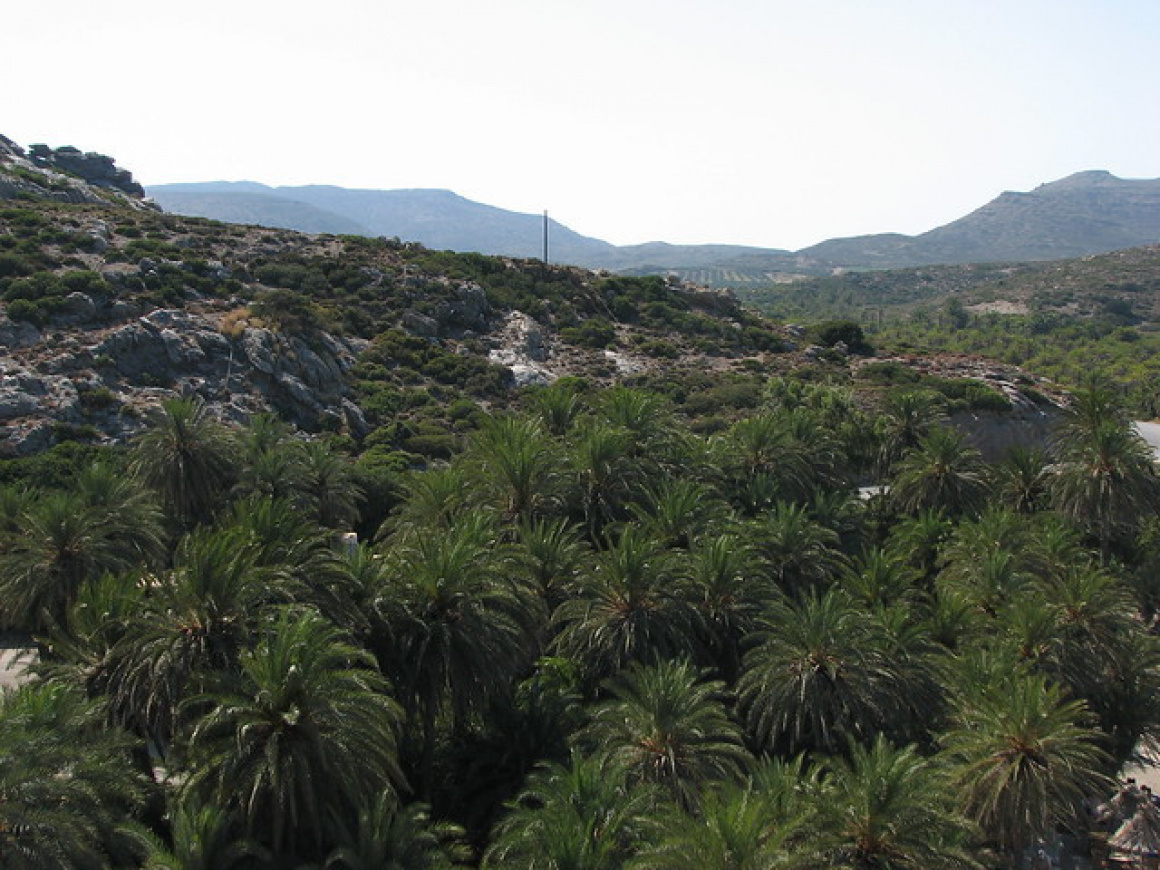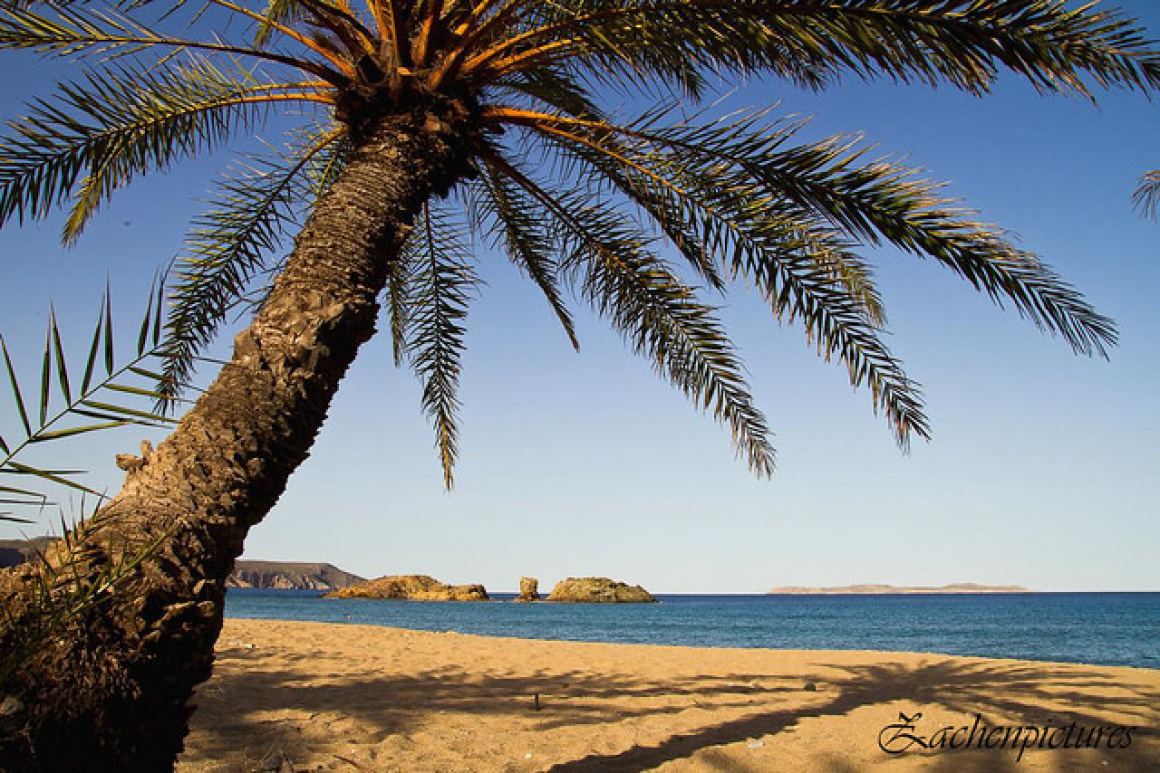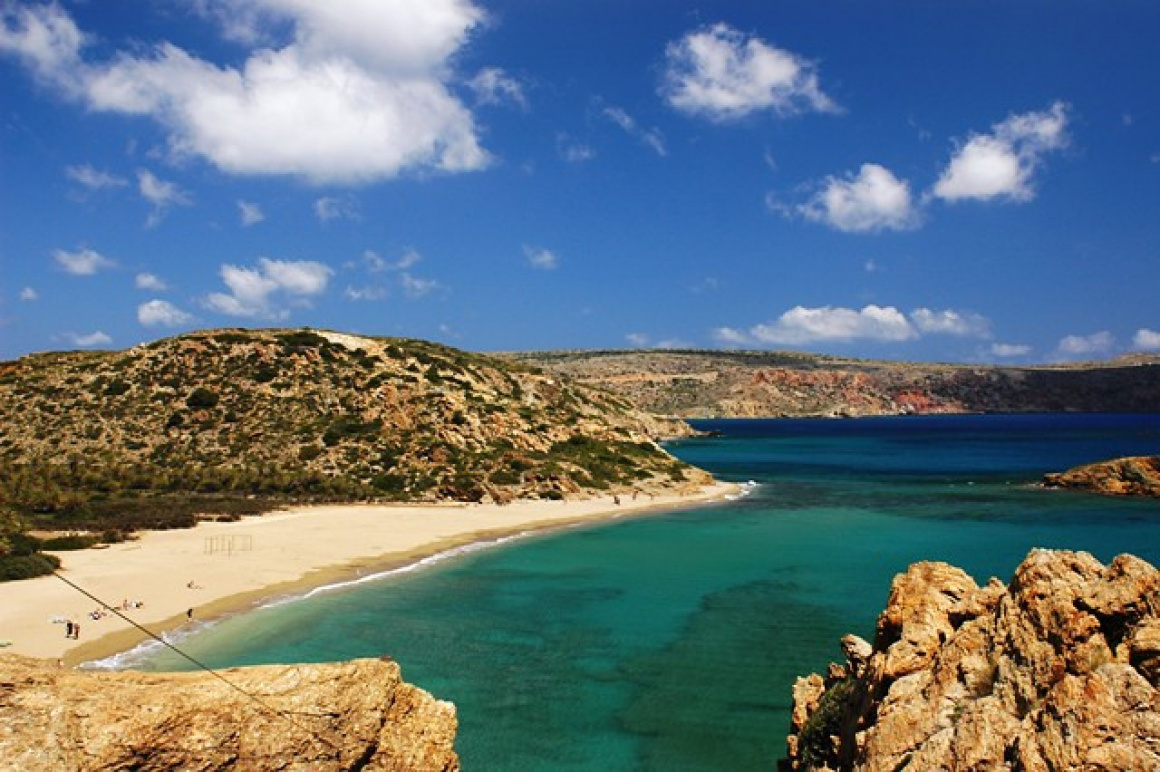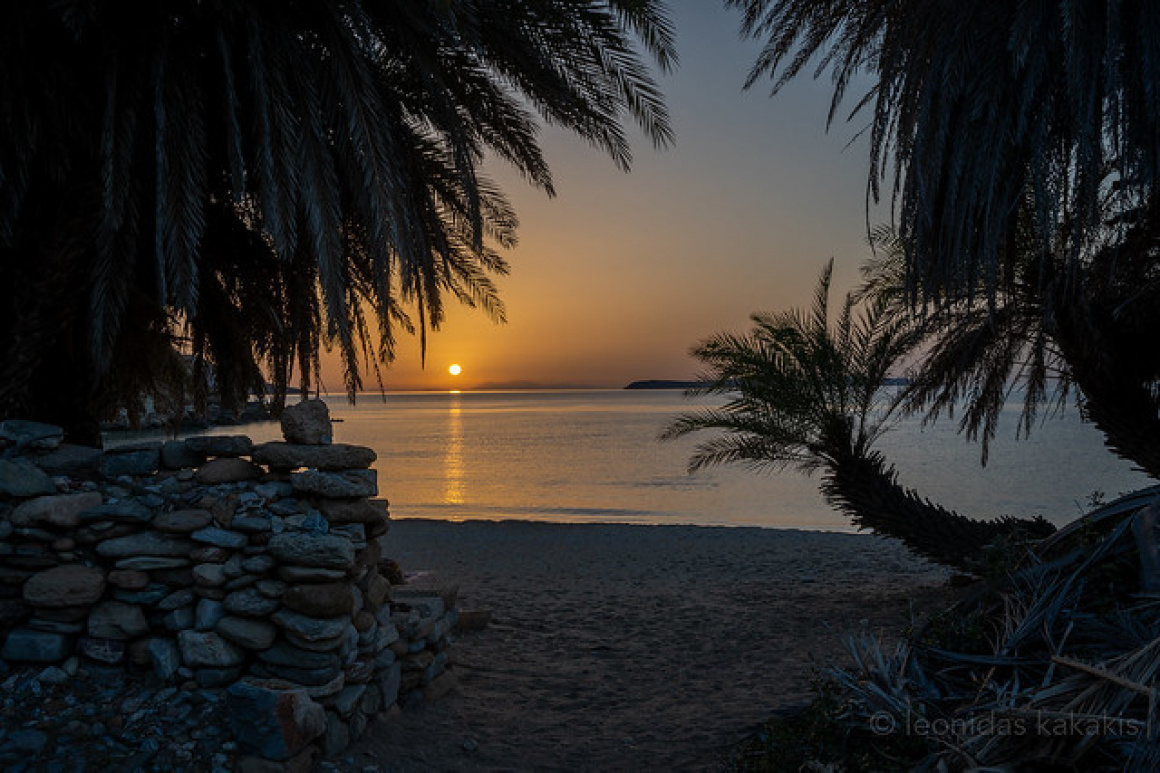Introduction
At the extreme eastern tip of Crete lies a beach that seems transplanted from the tropics. Vai Palm Beach – a crescent of fine golden sand framed by Europe’s largest natural palm forest – is a true oasis where the Mediterranean meets the exotic. As you arrive at Vai, you first glimpse the tops of thousands of palm trees swaying with the breeze. Follow the footpath from the parking lot and the view opens up: a broad beach kissed by aqua-blue waters, backed by a dense grove of endemic Cretan date palms. It’s a startling and enchanting sight, unlike any other in Europe. The name “Vai” actually comes from the Greek word for palm (vagia), and you’ll instantly see why. Whether you’re sunbathing under a palm’s shade, swimming in the crystal-clear bay, or climbing to the viewpoint that overlooks this paradise, Vai captures the imagination and the heart.
The Palm Forest: Myth and Reality
Vai’s palm forest is the largest of its kind on the continent, home to around 5,000 trees of the species Phoenix Theophrasti (Cretan date palm) covering about 60 acres. These palms are truly ancient residents – a rare species native to Crete and a few other Greek islands, survivors from prehistoric times. Of course, such an unusual grove inspires legends. According to local lore, Vai’s palms sprouted from date seeds left by foreign travelers. One popular tale says Arab pirates or Phoenician traders landed here centuries ago, feasted on dates, and tossed the seeds aside, giving birth to the forest. It’s a romantic image: swashbuckling pirates unwittingly planting paradise. However, botanists will tell you that the truth is even more fascinating – these palms are endemic and have been growing here naturally since antiquity. Crete’s mild climate and the freshwater stream that reaches the bay create the perfect micro-environment for the grove to flourish.

 'Vai' - Attribution: sergei.gussev
'Vai' - Attribution: sergei.gussevVai remained relatively unknown beyond Crete for most of history. Local farmers from nearby villages knew of the “Palm Beach,” but it wasn’t until the 1970s that Vai’s fame exploded. In 1970, a British TV advertisement for a chocolate coconut bar depicted Vai as the ultimate tropical escape – “the taste of paradise” – beaming images of its palms into living rooms across Europe. The ad struck a chord and suddenly travelers, especially free-spirited backpackers and hippies (many drifting over from the famous hippie community at Matala Beach), sought out Vai.
Beach Bliss in an Exotic Setting
Vai offers a delightful mix of natural beauty and enough amenities to keep visitors comfortable (while still preserving the wild vibe beyond the main beach). The palm forest stretches inland in a valley behind the beach, its tall, slender trunks and feathery fronds creating a dappled shade. You can take a short walk on wooden boardwalks that enter the edge of the grove (signs remind visitors not to venture off-path or light fires – the palms are protected treasures). In spring, creamy white clusters of palm flowers hang from the trees, eventually yielding small dates that feed the local wildlife (yes, Vai has its own mini-ecosystem, including birds and shy kri-kri goats sometimes seen on the cliffs).

 'Vai Palm Beach/Crete/Greece' - Attribution: Balance-Photography.com
'Vai Palm Beach/Crete/Greece' - Attribution: Balance-Photography.comThe beach itself is a broad arc of sand with shallow, calm waters – perfect for swimming and families. The sea here is usually gentle, as the bay is sheltered. Wade in and you’ll find a mostly sandy bottom with bits of seagrass further out, and perhaps a few curious fish darting around. On windy days, the scent of the palms mixes with salty air, a refreshing natural perfume.
Vai is a Blue Flag beach, which means it’s clean and well-maintained. You’ll find rows of sunbeds and umbrellas available to rent on the central part of the beach (in season). Given the popularity of Vai in summer, grabbing a sun lounger early is advisable, especially in July–August when tour buses arrive by the dozens. If you prefer a more natural experience, simply lay out a towel at either end of the beach, beyond the organized area – you’ll be closer to the palms and further from any crowds.

 'Vai Palm beach, east Crete' - Attribution: Character Hotels of Greece
'Vai Palm beach, east Crete' - Attribution: Character Hotels of GreeceOne of the best little adventures at Vai is to climb the viewpoint trail on the north side of the beach. A marked path with steps leads up a rocky hill. It’s a 5-minute climb that rewards you with a postcard-perfect panorama: the entire palm forest stretching up the valley like a green river, the golden beach curving along the turquoise sea, and the endless blue beyond. This is the angle that launched Vai to fame, seen in countless photos. Bring your camera (and perhaps your social-media pose) because it’s truly spectacular. Sunrise lovers note: since Vai faces east, an early morning visit will give you a magical scene of the sun rising from the sea, gilding the palms in soft light – well worth the effort if you’re staying nearby.
For those interested in snorkeling, the rocky sides of the bay (especially the right/north end by the viewpoint trail) offer some fish life and underwater rock formations. It’s not a major snorkeling destination, but you might see schools of small Mediterranean fish and even the occasional octopus hiding in crevices. Water clarity is usually excellent.
At the back of the beach, a cluster of low-key facilities is housed in a single building discreetly tucked among the palms. Here you’ll find a beach tavern/café where you can grab cold drinks, ice cream, or simple Greek dishes (like souvlaki, Greek salad) – very handy for a beach day. There are also restrooms and showers which are free to use for beachgoers. The parking lot is just beyond. Note that in peak season, the parking can fill up by late morning; an attendant may guide you to park along the access road once the lot is full.
Beyond the beach, the surrounding area has a couple more points of interest. Just north of Vai are the ruins of Ancient Itanos, an archaeological site with remnants of a Greco-Roman town (free to explore). If you’re up for a short hike (around 15–20 minutes), you can walk to two quieter coves near Itanos, often nearly empty if Vai feels too crowded. To the south of Vai, about 6 km away, is Toplou Monastery, a 15th-century fortified monastery famous for its icons and excellent local wine – a great cultural detour on your way to or from the beach.
Getting There:
Vai is remote by Cretan standards. It lies about 30 km east of Sitia (the nearest town with an airport) and approximately 8 km from the village of Palekastro. By car, it’s roughly a 1.5-hour drive (94 km) from Agios Nikolaos, or 2.5–3 hours (150 km) from Heraklion, mostly on winding roads once you pass Sitia. A private vehicle or scooter is the easiest way to reach Vai. The route is scenic, especially the last part skirting the rugged coast and passing Toplou Monastery. If you don’t have a car, in summer there are daily buses from Sitia to Vai (via Palekastro) – check KTEL bus schedules. Alternatively, some tour operators offer day trips from major resorts to Vai, often combined with other eastern Crete sights.
When to Visit:
Vai Beach is accessible year-round, but facilities operate in the tourist season (approx May through October). In July and August, expect large crowds from mid-morning to late afternoon. To enjoy a more peaceful Vai, consider coming in shoulder season (May, early June, or September) when the weather is still warm but the tourist rush less intense. If visiting in peak summer, arrive early (before 10 AM) to snag a good spot and enjoy the palms in relative solitude. By noon, the center of the beach can resemble a busy resort with music from the café and lots of activity. Things quiet down again in the later afternoon as the tour buses depart – another great window to relish the setting. Keep in mind the palm grove closes around sunset; no one is allowed to remain on the beach overnight (and camping is strictly forbidden).

 'Palm Beach' - Attribution: Leonidas5
'Palm Beach' - Attribution: Leonidas5Rules & Preservation:
Vai’s uniqueness comes with responsibility. The area is protected, so respect all signs and barriers. Do not attempt to camp, make fires, or pick the palm fronds (the trees are sensitive). There’s a fence around much of the forest to prevent trampling of young palms – stick to designated paths. Also, wild goats roam the area and sometimes wander onto the beach; as cute as they are, please don’t feed them human food, which can harm them. The beach is generally very clean – let’s keep it that way by using the provided trash bins or taking your rubbish with you. If you’re visiting in late summer, you might notice some dried dates on the ground; the temptation to taste them is understandable but note they are quite fibrous and not like the cultivated dates you buy at a store!
Services:
Aside from the main café, a couple of seasonal cantinas often set up near the parking in summer, offering snacks like corn on the cob, fresh orange juice, or crepes. Local vendors might also sell Cretan honey or postcards. There are sunbed/umbrella rentals (around €10–€15 for a set per day). If you’re on a budget or prefer the sand, bring your own beach mat or umbrella. Natural shade can be found in the morning under palms at the very back, but as the sun moves higher, you’ll want proper sun protection. The parking at Vai is usually free (managed by the local commune) and accommodates a good number of cars and tour buses.
Nearby Lunch Options:
The beach café is fine for a quick bite, but for a sit-down meal consider driving 10 minutes to Palekastro village after your beach time. Palekastro has excellent tavernas – such as Vaios or Elia – serving fresh seafood, Cretan dishes, and of course the local specialty koufeto (a sweet with honey and sesame). There’s nothing quite like ending your Vai excursion with a late lunch of grilled fish and a view of the hills, or perhaps a wine tasting at Toplou on your way back (the monastery has a tasting room for its organic wines).
Recommended Hotels Near Vai
While Vai itself is a protected area with no accommodations, you have a couple of great options in the vicinity to make an early or extended visit easy:
Castri Village Hotel – Perched on a hillside just outside Palekastro, this relaxed aparthotel offers sweeping sea views (you can even glimpse the palm tops of Vai in the distance). Rooms are apartment-style with kitchenettes, ideal for families or longer stays. Guests love the beautiful pool that overlooks the countryside. It’s about a 10-minute drive to Vai Beach. Waking up at Castri Village and heading to Vai at sunrise is a popular strategy to beat the crowds.
Hiona Holiday Hotel – Located in Palekastro village, this small hotel puts you close to local tavernas and the vibe of a genuine Cretan village. It’s clean, budget-friendly, and the staff are known for their warm hospitality. The hotel is also near Hiona Beach (a lovely lesser-known beach) if you want a break from Vai. In the evenings, you can stroll through Palekastro’s quiet streets or enjoy a raki with the locals in the square.
Sitia Beach City Resort & Spa – If you prefer a touch of luxury and more facilities, base yourself in Sitia town at this four-star resort. It’s a 30-minute drive from Vai, and after exploring the wild east, you can return to a full-service hotel with pools, spa, and a beachfront location in Sitia. It makes a great hub to explore not just Vai but also other eastern Crete attractions like Kouremenos (wind surfing hotspot) and the Richtis Gorge.
(See also our guide to Toplou Monastery – many visitors combine it with Vai – and Zakros Palace if you’re venturing further east.)

